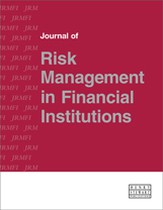Value optimisation in a regulatory constrained regime — A new look at risk vs return optimisation
Abstract
Basel II made Pillar I's regulatory capital (RC) more risk-sensitive and brought it closer to economic capital (EC). In many financial institutions (FIs), RC is close to, or even larger than, EC. Constrained by RC, many FIs have been using RC in addition to, or as a replacement for, EC for capital allocation, performance management and even for pricing/deal acceptance to ensure a sufficient return is provided to shareholders. Although Basel II's RC provides a much better estimation of risk relative to Basel I, it still comes short in many areas—most notably in concentration and diversification risk which is essential for value optimisation. Owing to its ability to more accurately capture concentration and diversification, its larger coverage and overall better accuracy, EC should be the primary metric in risk return optimisation for the entire bank. RC, on the other hand, is a regulatory reality and a very strong constraint which is likely to be stronger with the implementation of Basel III. In this paper value optimisation in a regulatory constrained regime is examined. An optimisation model is proposed to allocate both EC and RC to FIs’ business units so that net economic profit for the entire bank is maximised subject to constraints. An empirical study is conducted and the results are interpreted. It was found that there are significant differences in net economic profit (NEP) and return on capital (ROC) among alternative risk and growth strategies which can be recognised by using an optimisation model which can be easily operationalised. FIs over-focusing on net income (NI) without a proper optimisation framework in their annual planning exercise are unlikely to determine and to be able to take advantage of these value maximising opportunities. It is also clear that the existence of RC affects the optimisation problem significantly and creates economic cost even when at the total bank level total RC is less than the total EC requirement. With Basel III implementation, if RC, as expected, becomes more of a binding constraint, the systemic inefficiency and thus the economic cost will further increase. Significant value can be created by increasing confidence in EC and by not imposing RC as a binding constraint.
The full article is available to subscribers to the journal.
Author's Biography
Peter Miu teaches courses in financial economics and international financial management at the DeGroote School of Business, McMaster University, Canada. His research has been conducted primarily in such areas as credit risk modelling and management, empirical methods and investments. Peter has acted as consultant on such issues as validations of credit risk measures, regulatory capital for issuer risks and stress testing models.
Bogie Ozdemir is a Vice President in Sun Life Financial Group. He is responsible for economic capital and is building out its capabilities for Solvency II/Own Risk and Solvency Assessment (ORSA) and model validation. Bogie was a Vice President in the BMO Financial Group responsible for economic capital, stress testing and Basel analytics, and jointly responsible for the Internal Capital Adequacy Assessment Process (ICAAP). Previously he was a Vice President in S&P’s Risk Solutions, globally responsible for engineering and implementing new solutions and business development. He has co-authored various papers and a book on Basel II implementation.
Michael Giesinger is an Associate Director in the Wholesale Credit Risk group with Barclays plc. He supports the setting of the bank’s risk appetite through the monitoring of exposure and capital limits. In particular, he has oversight over the stress testing process. Michael was a Manager in the BMO Financial Group with responsibility for economic capital methodology development and stress testing. He has also previously worked in insurance and pension consulting.
Citation
Miu, Peter, Ozdemir, Bogie and Giesinger, Michael (2011, December 1). Value optimisation in a regulatory constrained regime — A new look at risk vs return optimisation. In the Journal of Risk Management in Financial Institutions, Volume 5, Issue 1. https://doi.org/10.69554/YBSU8754.Publications LLP
